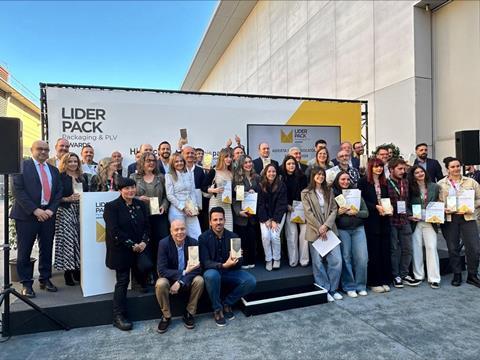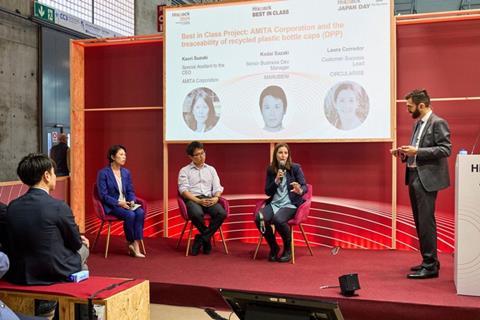In recent years, packaging and sustainability have become virtually impossible to separate, and across Europe and the world, manufacturers and brands are working on adapting packaging and its associated production and logistics processes to new regulatory frameworks, notably the Packaging and Packaging Waste Regulation within the EU.

This development was also confirmed at the 19th edition of Hispack, the trade show that took place in Barcelona from May 7th to May 10th, 2024. A total of 819 exhibitors from 28 countries showcased innovations from across the packaging value chain. The figure of 26,000 visitors marked an increase of 11% compared to the 2022 edition. Elisabeth Skoda takes a look back at the event.
The event spotlighted the latest trends and solutions implementing the circular economy based on the reduction, recycling and reuse of materials, packaging and packing.
Xavier Pascual, the director of Hispack, underlined “the generalist nature of the trade fair as one of its strong points when it comes to bringing together professionals from different industries, as well as its role in facilitating the permeability of innovation and cross-knowledge about packaging between various sectors”.
The Minister of Industry and Tourism of Spain, Jordi Hereu, visited Hispack to see first-hand the sustainability innovations presented by exhibitors. Hereu pointed out “the magnificent thermometer of the industrial climate that the fair represents, because if the packaging industry is doing well, it means that other user industries are increasing their demand”.
Zooming in on the Spanish packaging landscape
Hispack carried out a study and analysis of the Spanish packaging market. The report titled ‘Packaging in Spain, the power of an industry committed to sustainability’ was launched just before the start of the event. It was produced by the consultancy firm MarketADD.
The report confirms the strength of the industry in a complex geopolitical and economic context marked by restrictions on certain raw materials, energy prices, high inflation, and the latest regulatory changes aimed at increasing the contribution of packaging to sustainable development.

One notable observation is that the Spanish packaging industry has been growing, increasing its turnover by 22% and the number of companies in the sector by over 8% compared to figures from the previous report from 2022. 90% of these companies are SMEs.
By subsectors of activity, the largest number of firms belong to manufacturers of packaging and plastic materials (900), followed by paper and cardboard (710), packaging machinery (615), wooden packaging (702) and manufacturers of labelling, coding and marking equipment (301). The list is completed with manufacturers of metal packaging (165); glass (40); cork stoppers (12); and other materials (2).
In terms of geographical distribution, Catalonia accounts for almost 30% of the companies, with an additional 40% distributed between Valencia (18%), Madrid (10.31%), Andalusia, which is experiencing strong growth, reaching 9.72%, and Murcia (6.3%).
The report also maps the sector’s business growth. The rising market demand for sustainable packaging has helped to increase the turnover of paper and cardboard companies by 24.4%. Plastic packaging companies are second with a turnover of 9,592 million euros, followed by packaging machinery, with a turnover increase of 12.32%.
The remaining areas also recorded notable increases in turnover: the labelling, coding and marking sector reached 3,395 million euros, up 11.6%; the wooden packaging sector 3,292 million (+24.7%), metal packaging, 3,259 million euros (+27.9%) and glass, 2,478 million euros (+25.7%).
Key factors for the growth within the sector reflected on this study feature the necessary transformation towards the sustainability of packaging, the automation and digitisation of the industry, the post-pandemic economic recovery of different productive sectors with growing demand for packaging, and the growth of e-commerce that is tied to new packaging and logistics demands.
Digital transformation is also among the major challenges facing the sector, which most companies are working on. Companies in the packaging machinery sector invest 3.7% of their turnover in R&D, mainly to promote digitalisation to increase sustainability with automated and energy-efficient equipment capable of working with new materials.
Sustainability and growth
Sustainability is a big driver in the packaging industry. The Hispack 2024 report points out that, although the challenge of sustainability is not new, it is now more of a priority for companies due to the latest regulatory changes and the greater awareness of consumers who demand more environmentally friendly packaging.
Companies continue to innovate both in terms of materials and circularity solutions, and here, the main trends include the use of mono-materials, more recycled plastic and biodegradable raw materials, as well as the promotion of recyclability and reusability of packaging and the application of life cycle analysis formulas for each product to adapt the solution with the lowest possible environmental impact.
Product innovation
A range of companies took the opportunity to launch their innovations at Hispack. To give just a couple of examples, Mespack presented the new MLC Series, a high-speed vertical form-filler-sealer for larger formats with a continuous welding system – a device which the company says is capable of producing up to 2,400 envelopes per minute in 16-track mode. This solution reportedly offers a reduced footprint and a format change in less than a minute, producing 160 envelopes/m2.
Lecta exhibited its portfolio of packaging products, including paperboard for luxury packaging, functional solutions for single-use containers, papers for shopping bags, and self-adhesive materials for multiple applications at the event, and unveiled its range of papers for flexible packaging, with heat-sealing properties and protection barriers.

Hispack 2024 also saw the awards ceremony for the winners of Liderpack, a contest organised by the Spanish Packaging Association, Graphispack Association and Hispack. Confirming a trend across the industry, sustainability was a major theme. Products awarded included a cardboard container for honey, a recyclable single-material medicine blister, a refillable case for cosmetics, a cardboard lid for the transport of paella and reusable packaging that can be reassembled and assembled.
At Hispack itself, the Best in Show winners were unveiled.

In the Packaging category, there were two winners: Panettone 118 (Mr. Ripley) - a pack for the “best chocolate Panettone in Spain 2022” made by Eric Ortuño at L’Atelier Barcelona. The self-assembly square box, printed on both sides, allows the product to be transported, served directly at the table and any leftovers to be kept. It is also designed for in-store display. The design plays with the word Pantone/Panettone.
The second winner in the Packaging category was a high barrier recyclable stick suitable for pharmaceutical products by Rotorprint. It does not contain aluminium or polyester so it can be recycled. Raw material usage is reduced by more than half.
In the POS category, the Best in Show winner was Animation Lancôme Summer (Adaequo, S.L.) with set of elements simulating suitcases and travel boots for the summer campaign with a display of fragrance and make-up products. They incorporate leatherette handles and chromed metal terminals.
Engaging content
Hispack featured a range of panel discussions and presentations on topics relevant to the packaging industry, from PPWR, the circular economy, recyclability to packaging design, logistics and more.
One highlight on Thursday, May 9th was Japan Day, which allowed visitors to discover the trends, challenges and opportunities in the Japanese packaging sector, and to explore how the challenges Japan faces, for example around demographics and large urban populations are applicable to Europe, and what we could learn from each other. It featured Takehiro Kaneko, Manager of the Packaging and Transportation Division of the Japan Packaging Institute talking about Japan’s drive towards sustainability and packaging regulation, in particular the 2022 Plastics Resource Circulation Act. Next up, Yoshinori Kumasaka, director of Shiseido‘s Sustainable Development Acceleration Department, spoke about how to achieve sustainable packaging and premium value, highlighting Shiseido’s effort to boost reusable and reduced packaging design and replacing materials for a low environmental impact, using recycled and plant-derived materials.
Furthermore, as part of the event, Hispack’s Best in Class initiative showcases and recognises the “most relevant projects in the transformation of industrial sectors taking place in Europe and beyond.”

This year, the recognition went to Kao Corporation for their technology for recycling and recovering resins from its refillable pouches, popular in Japan. The system allows clean recovery of resin from multilayer packaging for new uses and products.
Moreover, a second recognition went to a project by Aarhus City Council and Tomra, who operate a “world-first” take-away reuse systems for beverage containers in the city of Aarhus, with 330.000 in habitants. The project implements a system for the collection, treatment and reuse of polypropylene takeaway containers.
Last but not least, AMITA Corporation, joined by partners from the Japan Circular Economy Platform, Circularise and Marubeni, deployed an initiative in Kobe in Japan to trace the recycling process of PET beverage bottles through new digital technologies of European origin in the development of a Digital Product Passport for packaging materials.
Hispack returns to a three-year cycle and will be back from May 4th to May 7th, 2027.
If you liked this story, you might also enjoy:
How are the top brands progressing on packaging sustainability?
The ultimate guide to global plastic sustainability regulation




















No comments yet